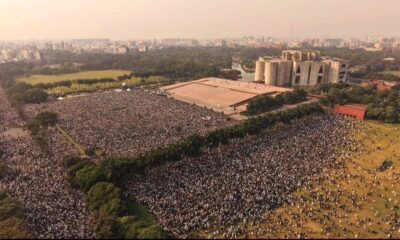Breaking
US Military Strikes Targets Iranian-Backed Houthi Group in Yemen

In a significant escalation of military engagement in the Middle East, the United States military has confirmed it has conducted air and naval strikes against the Iranian-backed Houthi rebel group in Yemen. This operation targeted 15 specific sites used by Houthis to launch a series of aggressive maritime attacks on commercial vessels traversing the strategically vital Red Sea.
Pentagon articulated that strikes were executed to “protect freedom of navigation” in response to Houthis’ persistent assaults on shipping in the region. Se operations come in the wake of increased tensions, as the Houthi group has been implicated in nearly 100 attacks on merchant ships since November 2023, resulting in the sinking of at least two vessels. Houthis have publicly framed the maritime assaults as retaliation against Israel’s military actions in Gaza.
Reports from the ground indicate a series of explosions were heard in major urban centers across Yemen, including the capital, Sanaa. Local Houthi-aligned media have confirmed that the Yemeni capital was among cities affected by US strikes, marking a significant intensification of military actions in a region already beleaguered by years of conflict.
Central Command, which oversees US military operations in the Middle East, has stated that recent strikes targeted Houthi weapon systems, bases, and or military equipment deemed critical to the rebel group’s operational capabilities. Houthi leadership, meanwhile, has claimed responsibility for downing a US-made MQ-9 Reaper drone over Yemeni territory, an assertion the US military later confirmed as true.
Recent military actions follow an assertion from the Pentagon last week regarding Houthis’ launch of what was described as a “complex attack” on US Navy ships operating in the region. While the US Navy successfully intercepted all missiles fired during this incident, the episode underscored the escalating threat posed by Houthis and ir ability to project military power beyond Yemen’s borders.
The City of Sanaa has enjoyed a relative respite from aerial bombardments over the past two years, following a significant de-escalation in hostilities between warring factions in Yemen. However, current developments signal a potential shift back to more intensive military engagement.
In addition to maritime attacks, Houthis have directly targeted Israel, firing missiles and drones at the country. Notably, in July, a drone launched from Yemen struck Tel Aviv, resulting in one fatality and ten injuries. Following this attack, Israel responded with airstrikes targeting sites within Yemen. Last month, several additional missiles were fired at Israel, including an attack that targeted the country’s main international airport.
The international community remains concerned about the broader implications of the ongoing conflict in Yemen, particularly as it relates to regional stability. In response to the Houthi threat, the US, UK, and a coalition of twelve nations initiated Operation Prosperity Guardian earlier this year, aimed at safeguarding Red Sea shipping lanes against potential Houthi incursions.
Houthis, as part of a broader network of armed groups in the Middle East that includes Hezbollah in Lebanon and Hamas in Gaza, received backing from Iran. This relationship has raised alarms about the increasing influence of Iran in regional conflicts, exacerbating tensions between the US and its allies and Tehran.
As military operations continue, the potential for broader conflict remains a pressing concern, with the situation in Yemen becoming increasingly intertwined with ongoing geopolitical struggles in the Middle East. Analysts warn that unless a diplomatic resolution is sought, the cycle of violence may deepen, further destabilizing an already volatile region.
- US warships and planes strike Houthi targets in Yemen BBC.com
- US air strikes target several cities across Yemen Al Jazeera English
- US military strikes 15 Houthi targets in Yemen Reuters












